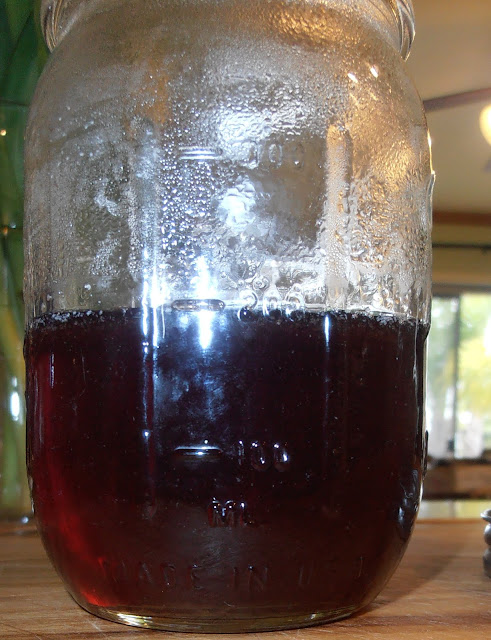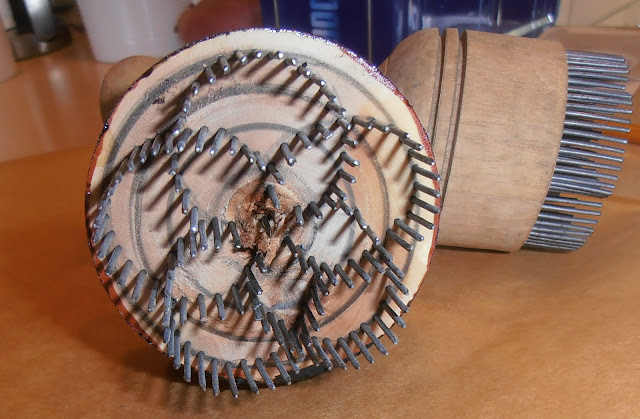A loquat, in case you didn't know, is a semi-tropical fruit that happily grows in my area and I have a decent-sized tree on my property. It has produced fruit before but this year, it outdid itself. I have picked over 120 pounds of fruit so far and it looks like another 20 to 40 are still on it. I have made loquat jam, loquat chutney, spiced loquats, and loquat liqueur. I have 12 pounds cleaned and frozen, waiting for a break in my schedule. I've given away many pounds to friends. Loquats are lovely to eat fresh, so I've had a lot of that.
Here is a picture of my tree and a closeup of the fruit on the tree.
 |
| One heavily laden loquat tree |
 |
| Luscious, heavenly, flavorful loquats |
But today's recipe has to do with another springtime treat: Roses!
The wet winter and now cool, wet spring has my yard in full bloom and among the flowers are the roses I planted a few years ago. Two are highly scented and one of those has been producing flowers regularly. I decided I wanted to try something with the petals.
I turned to a book I used once before, when I made a Rosemary Tea Sherbert (part 1 and part 2). It is Flower Cookery -- The Art of Cooking with Flowers.
 |
| By Mary MacNicol, Fleet Press Corp, published 1967 |
Today's recipe is on page 164.
Rose Shrub
Take one and a half pounds of fresh rose petals, add three cups of water and boil up. Remove from heat and when cool, strain. Then add two and half pounds of sugar, and the beaten white of an egg, boil, skim, strain and bottle.
My Redaction
I picked all the rose petals I could off of the three rose bushes. The dark red roses aren't scented but I wanted them for color. The other two were deeply scented.
The recipe books all say to remove the bitter white base of the rose petals. I tasted them and found that only the red petals had a bitter base, which I tore off. The other bases were sweet.
 |
| A beautiful basketful, picked on a rainy day |
 |
| Rounding up to call it 6 |
24 ounces petals to 24 ounces water, so that scales down to 6 ounces of petals to 6 ounces of water.
Similarly, 2 1/2 pounds of sugar is 40 ounces (by weight), so
24 ounces petals to 40 ounces sugar gives
3 ounces petals to 5 ounces sugar. I had 6 ounces petals so I used 10 ounces of sugar.
That is not a lot of water but the roses took up so much volume that I chose to use my enameled cast iron Dutch oven. I put the water in the bottom and then packed the petals in on top.
 |
| A large pot filled with roses. |
After about 25 minutes, I turned the heat off and let the whole thing cool for a few hours. At no time during the cooking and cooling process did I lift the lid.
Once it was cold, I looked inside.
 |
| Now they are cooked down. |
 |
| Squished until they could offer no more. |
Then I strained the liquid through a fine sieve into a measuring cup and saw it was almost 8 ounces. I still decided to use the original 6 ounces of liquid quantity to determine the sugar amount because that is what the recipe seemed to indicate.
I put the liquid into a small saucepan and then I added the sugar and the entire amount of egg white, beaten. I suppose I could have put in a lot less white but I chose not to. I stirred it all together and put it over medium heat.
 |
| Just starting to warm up. |
 |
| Foam! You can see the boiling at this point, so I started skimming. |
 |
| Dark islands of syrup. |
 |
| Nearly done. |
 |
| 8 Ounces of Nectar! |
The Verdict
First we tasted it just as it was, straight out of the jar. It was definitely a sweet syrup, thick, with a lovely rose flavor. One tester is a person who does not generally like the flavor of roses. When she tried this, she liked it. She felt the sugar gave the taste enough body to feel like she was drinking something, instead of just getting a strong scent of roses. She also felt the rose flavor was an actual flavor and not just perfume.
Everyone liked it although we all agreed that it was too sweet to have more than just a sip or two.
So we tried it mixed with several other liquids.
Just adding cold water was okay but I think too much water was added; the ratio should be more like equal parts rose shrub and water but for me to say that, I will need to experiment more.
I also added equal parts tonic water, which was interesting because the tonic water is bubbly and has a bitter taste. That shifted the whole experience away from sweet, which I liked, and the bitter added an extra dimension in flavor. One taster, who does not like bitter, did not like the tonic water mix.
I mixed some of the shrub with a white wine, a little more wine than syrup. That was intriguing because I no longer got the definite rose flavor but it didn't taste like wine, either. It was a perfumed, fruity sensation that I truly liked. One tester thought it could be described as a "rose sangria". She does not normally like wine but felt this was a mixture she could drink, and she described it as "classy." I liked that.
We also mixed it with white wine vinegar. When it was about 2 parts shrub to 1 part vinegar, it was too tart for a beverage but we thought it would be a good sweet-and-sour glaze on roasted meat. At about 3 parts syrup to 1 part vinegar, it was a refreshing, sippable beverage. Actually, this is what I think of when I think about a beverage called shrub.
Success!
I want to make more (keeping blooming, my rose bushes!) and try it with other foods. I think it would be good in lemonade, or drizzled over fresh loquats (or strawberries), or on pancakes, or in my hot chocolate, or mixed with vanilla yogurt as a fruit salad dressing, or brushed on the top of a cake hot from the oven (white, yellow, or lemon cake).
















